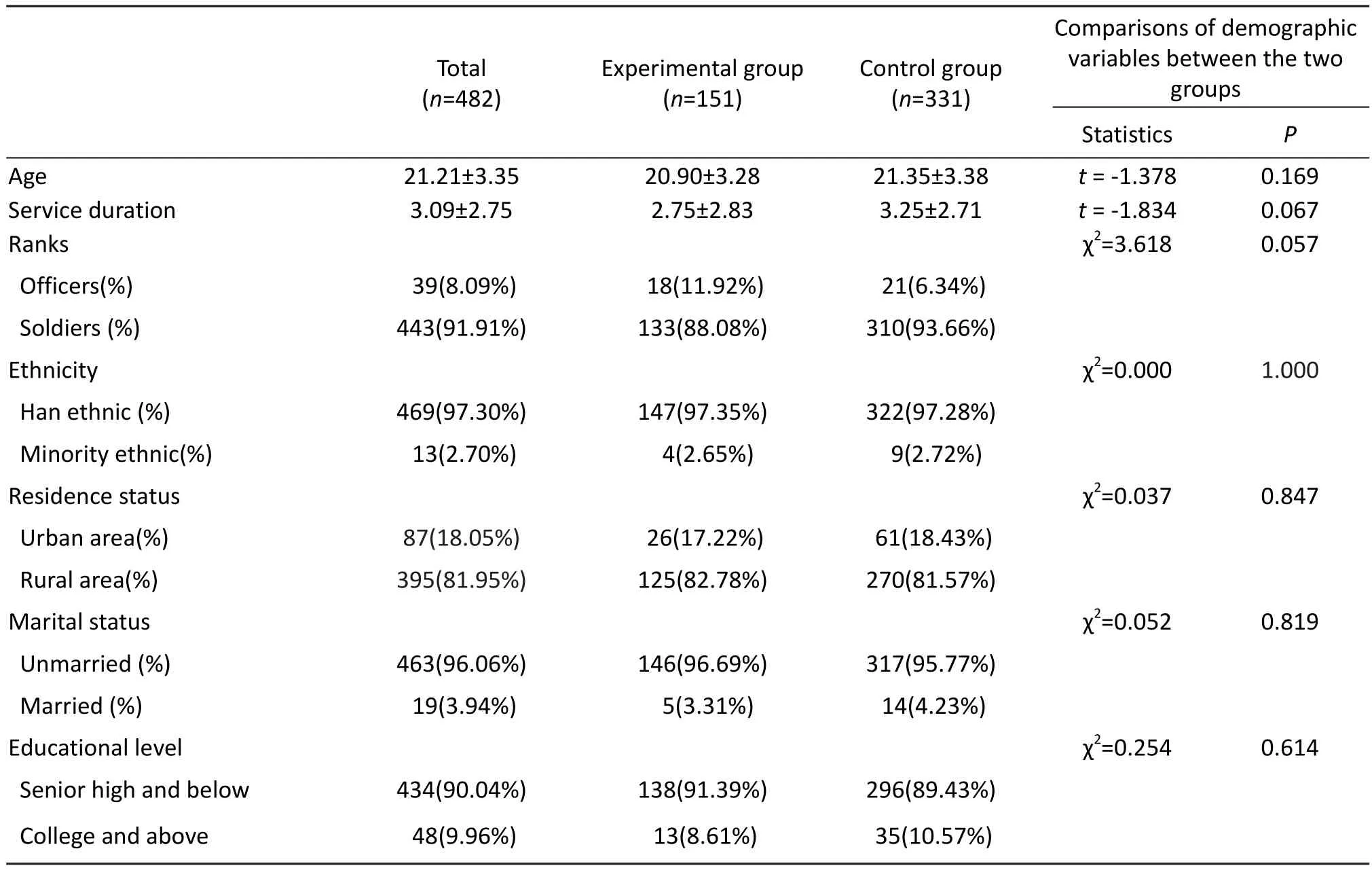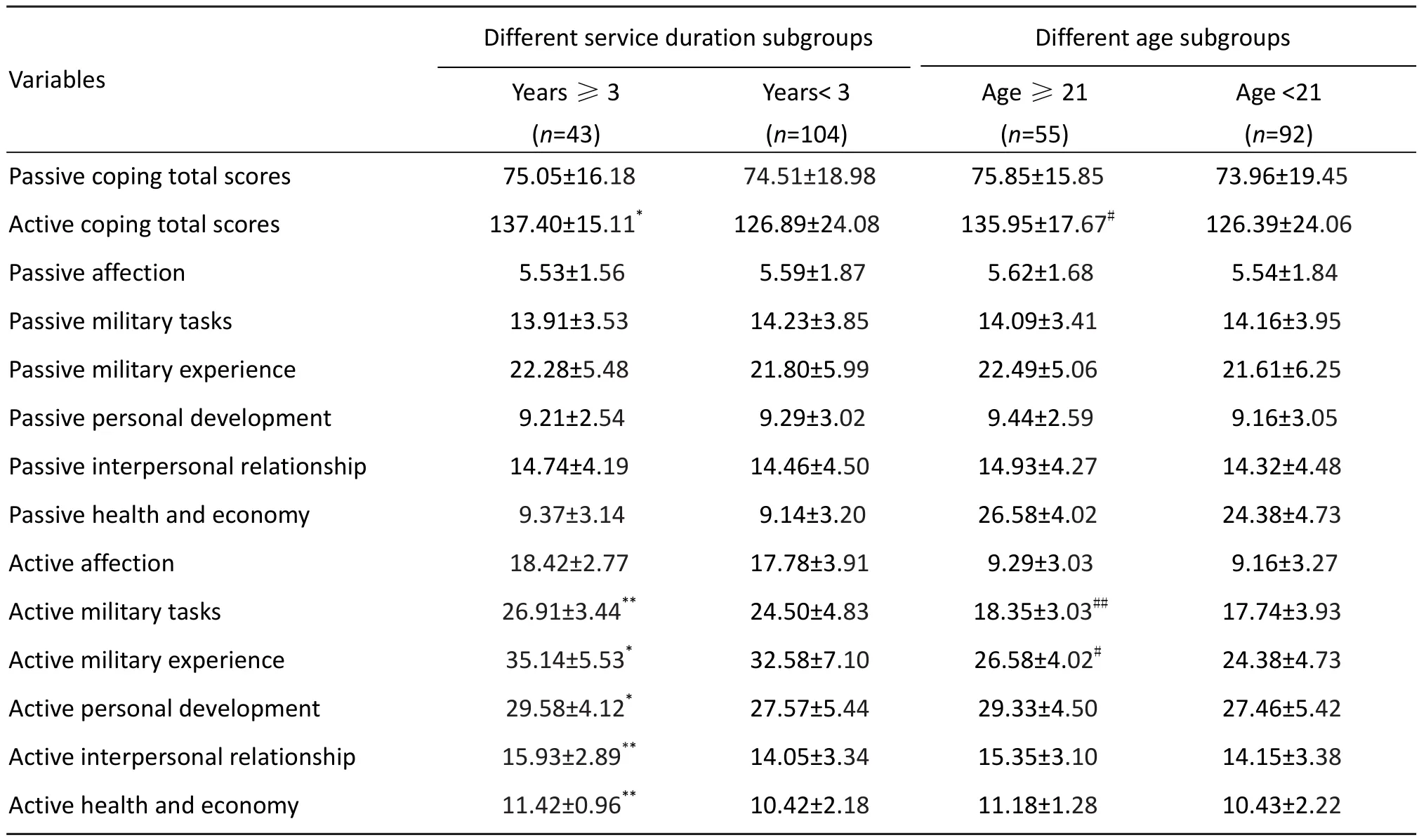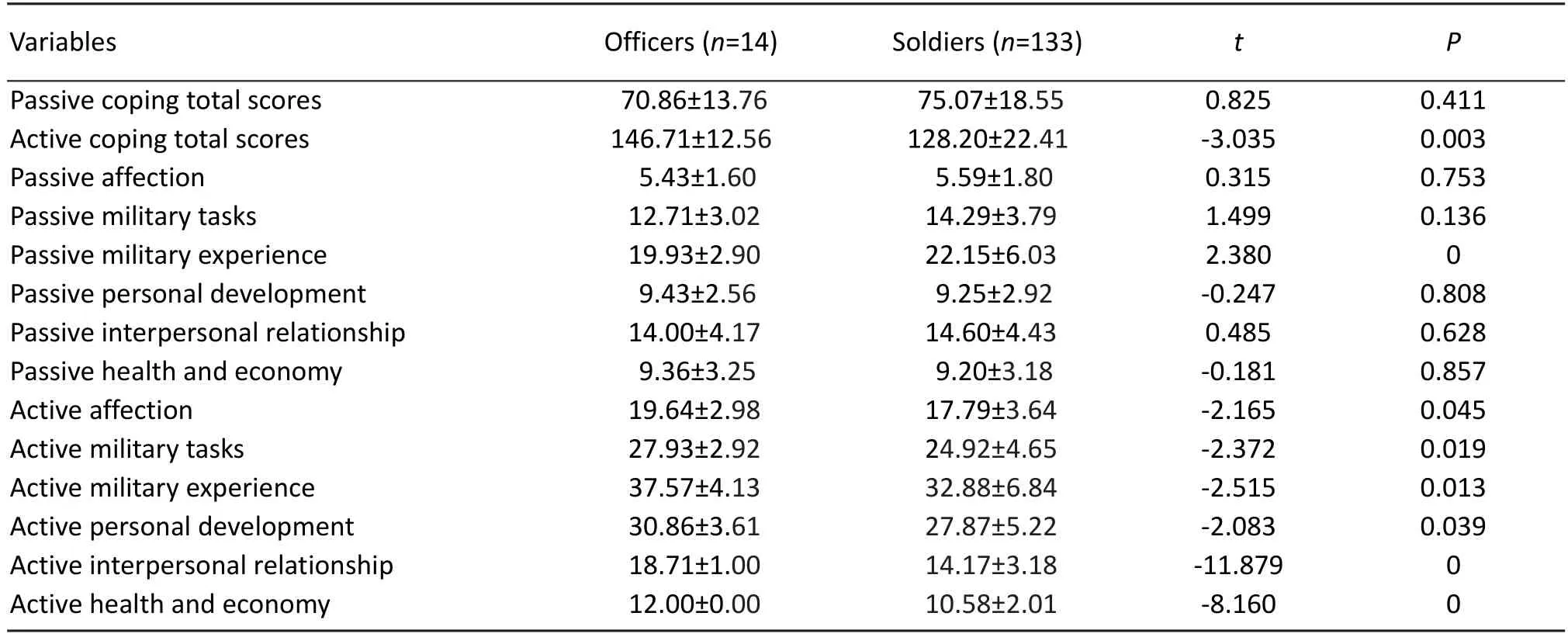Scene-trait coping style of military rescuers in Wenchuan earthquake
Li-yi ZHANG, Xin-yang SUN,2, Ling-ming KONG, De-hua TU, Liang ZHANG, Guang-yao LI,Zi-xiang SONG, Chun-xia CHEN, Gao-feng YAO, Jie SHI
1. Prevention and Treatment Center of Psychological Diseases, No.102 Hospital of Chinese PLA, Changzhou 213003; 2.Department of Psychology and Psychiatry, the Second Military Medical University, Shanghai 200433; 3. Department of Psychiatry, Ma’anshan Central Hospital, Ma’anshan 243000; 4. First Psychiatric Health Center of Civil Affairs Bureau,Shanghai 201105; 5. Department of Psychology, No.102 Hospital of Chinese PLA, Changzhou 213003; 6. Department of Pediatric Psychiatry, No.102 Hospital of Chinese PLA, Changzhou 213003; 7. Department of Psychology, General Hospital of the Second Artillery Force of the PLA, Beijing 100085, China
Introduction
Earthquake is very common and one of the most devastating natural disasters that aあect a significant number of people at the same time and create widespread adverse effects due to the fact that the prediction of or preparation for earthquakes is hardly possible[1]. Once earthquakes occur, tremendous attention would be poured out onto those victims,victims’ families, survivors and crisis management.Liang et al.[2] observed the eあect of post-earthquake rescue policies on health-related quality of life of survivors in Sichuan earthquakes and concluded that six post-earthquake policies, namely education,orphans, employment, poverty, legal, and social rescue policies, significantly improved the healthrelated quality of life of the survivors. Li et al.[3] discussed about mass collaboration in risk management, which was proven to be effective in a big public crisis such as the Sichuan earthquake[4].Fahriye et al.[1] examined the effectiveness of a psychoeducation intervention, including problem solving compared with intervention with medication on post-traumatic stress disorder (PTSD) symptoms and concluded that those survivors intervened by both psychoeducation and medication showed greater relief of symptoms[1]. Peter examined the varied responses from countries in Europe and NorthAmerica in the afermath of an earthquake and how this affected the children adopted in Haiti[5]. On the other hand, less attention has been paid to those rescue workers who were also exposed to horrific sights and extremely aversive scenes. Xu et al.[6,7]investigated the rescue efforts made by Chengdu Military Area Command for earthquakes in remote plateau regions, which require large numbers of professional personnel to be transported from various lowland regions, and observed the fact that rescuers unacclimatized to high altitude commonly suffered from acute mountain sickness(AMS),which made relief efforts inefficient and potentially dangerous. A number of studies investigated into the post-traumatic stress disorder (PTSD) among the rescuers involved in earthquakes[8,9], but there had been hardly any studies exploring the coping styles of earthquake rescuers.
Coping is a process that an individual, when dealing with some specific internal or external environment which is beyond his own ability by self-evaluation, makes changes in cognition and behavior[10], and it is an important intermediary variable between stressors and stress reactivity.In light of the horrific experiences associated with discharging earthquake relief task, a special importance has been attributed to coping strategies used by the military rescuers. Coping strategies are mechanisms defined as behaviors and cognitions aimed at dealing with the threat and passive emotions that accompany rescuers’ exposure to stressful situations[11,12]. If individuals under strong stresses were lack of proper coping style and social support, the incidence rate of psychological problems would be up to 43.3%, twice as much as that of the general population[13]. Overseas studies had shown that in the event of strong psychological stress such as earthquakes, those who applied active coping styles tended to have fewer psychological problems,while those who applied passive coping styles tended to have more ones[14]. Some related researches had been done in the military setting in China[15], but it was absolutely rarely reported domestically or internationally. Wenchuan earthquake was notorious for the deadliest in China’s recent history, injuring countless lives and wreaking immense havoc around the stricken region. Unlike other countries, military personnel would be sent in case of natural disasters as relief efforts in China as well as in case of war for combating against the enemy. Hence, batches of military rescue workers had been sent to the aあected region as relief efforts since Wenchuan earthquake struck. How would the military servicemen cope with stressful situations such as earthquakes?
In this study, we hypothesize that servicemen with longer service duration take more active coping strategies than servicemen with shorter service duration. The characteristics and related factors of scene-trait coping style used by the military rescue workers in the front line of Wenchuan earthquake relief efforts were explored in order to provide scientific evidences for mental intervention program for Chinese military personnel in disasters.
Materials and Methods
Participants
A total of 151 male officers and soldiers who participated in the rescue work of Wenchuan earthquake were chosen as the experimental group in this study. Another 331 servicemen in the identical military units whose title was forbidden to be identified due to military confidentiality were randomly selected as the control group. Their demographics are shown in Table 1. There were no significant diあerences between the two groups in age,ethnicity, military service duration, marital status,ranks, residence status, and educational levels.
Material
There are few rating scales around the world that are used to assess scene-trait coping style for civilian purpose, and fewer that are used to assess scenetrait coping style in the military setting, taking into consideration extraordinary military environment and exceptional nature of military activities. The Chinese version of the military personnel scene-trait coping style scale (MPSTCSS)[16] developed by the Prevention and Treatment Center for Psychological Diseases of Chinese People’s Liberation Army was used to assess coping style of Chinese military rescuers in Wenchuan earthquake relief effort. It consists of 90 items in two major aspects, namely passive coping style and active coping style, in terms of affection, military tasks, military experience,personal development, interpersonal relationship,health and economy, and also including a lying factor.It was designed to be a four-point Likert response format, with never true scoring 1, sometimes scoring 2, frequently scoring 3, and always scoring 4. The higher is the score, the stronger is the inclination of corresponding items. The reliability and validity of this rating scale have been verified by a series of tests among new military recruits, annual psychological screening[17] and the third parties[6]. Cronbach’s alpha coefficient and the split-half reliability of the general scale were verified to be 0.806 and 0.808 respectively, while Cronbach’s alpha coefficient and the split-half reliability of the subscales ranged from 0.723 to 0.805 and from 0.694 to 0.899 respectively(P<0.01). The correlation coefficients between all subscales and the general scale were ranged from 0.719 to 0.912 (P<0.01). All these parameters have demonstrated that the military personnel scene-trait coping style scale has excellent reliability and validity,meeting the strictest psychometric standards.

Tab. 1 Demographic variables by different groups.
Procedure
The post-deployment survey was conducted in the two groups in the 3rd week afer the servicemen had accomplished their mission and returned to their military residence. Ethical medicine committee approval was sought from No.102 Hospital of Chinese People’s Liberation Army before the study was commenced. Working staff explained the inventory and the purpose of the study to all participants before the procedure. All participants were ensured confidentiality on their test results and were not requested to fill out their names to dispel misgivings. All data collected after the procedure were carefully checked out by cross validation before analysis in order to exclude questionnaires, which were randomly answered, or answered incompletely,or the lying factor score being more than mean plus 1.96 standard deviation. Altogether 4 pieces out of the 151 questionnaires in the experimental group were excluded from this study, leaving 147 pieces and making the effective rate 97.35%, and 3 pieces out of the 331 questionnaires in the control group were excluded, leaving 328 pieces and making the effective rate 99.09%. Subgroups were then created in the experimental group for further investigation,in terms of age less than or more than 21 years,military service duration less than or more than 3 years, and ranks of the officers and soldiers. The 21-above (included) age subgroup turned out to be 55, leaving 92 in the 21-below age subgroup. そreeyear plus (included) service subgroup was 43, leaving 104 in the 3-year minus service subgroup. そe oきcer subgroup was 14, leaving 133 in the soldier subgroup.
Statistical analysis
All data were processed in SPSS version 13.0. The frequencies of demographics were first obtained and compared between the experimental group and the control group using independent sample t test and chi-squared test to evaluate the homogeneity of the groups. Independent sample t test was then also performed to compare factor scores of MPSTCSS between the experimental group and the control group, between different age subgroups, different military service duration subgroups and different ranks subgroups in the experimental group.
Results
Comparison of MPSTCSS factor scores between the experimental group and the control group
The total score and all factor scores of active coping style, plus passive affection, passive health and economy of the experimental group were significantly higher (P<0.05,P<0.01) than those of the control group respectively (Tab. 2).
Comparison of MPSTCSS factor scores between diあerent age subgroups and diあerent military service duration subgroups of the experimental group
そe results indicated that the 21-above age subgroup reported significantly higher (P<0.01) active total score and active factor scores in military tasks and military experience than those of the 21-below age subgroup respectively. The 3-year plus service subgroup reported significantly higher (P<0.05,P<0.01) active total score and active factor scores of military tasks, military experience, personal development, interpersonal relationship, health and economy than those of the 3-year minus service subgroup respectively (Tab. 3).
Comparison of MPSTCSS factor scores between diあerent ranks of the experimental group
The results demonstrated that the officer subgroup had significantly higher (P<0.05,P<0.01) active total score and active factor scores of affection, military tasks, military experience, personal development,interpersonal relationship, and health and economy than those of the soldier subgroup respectively,while the score of passive military experience was significantly lower (P<0.01) than that of the soldier subgroup (Tab. 4).
Discussion
As a special group of population, the servicemen are influenced by extraordinary military circumstances,that renders the servicemen’s psychological status taking on some unique characteristics[15,18-20],which have been taken into consideration during the development process of the MPSTCSS. This rating scale is not only able to test individual servicemen’s general tendency, but also able to measure the psychological quality changes when facing different situations, which exactly reflects the scene-trait coping style[16]. そus, this scale was qualified to be used to test the coping style of officers and soldiers who participated in the Wenchuan earthquake rescue work.
When facing emergent and stressful situations,various coping strategies would be applied, and the combination of the strategies is changing according to the change of time and scenarios[2]. Generally speaking, how to choose the coping style is decidedby personality, individual diあerences, and situational stress. In this study, the results suggested that the officers and soldiers in the experimental group adopted more active coping style than those in the control group. Older servicemen would take active coping style more ofen, particularly in military tasks,military experience, and personal development,than the younger ones respectively. そe servicemen with longer military service duration tended to use active coping style more often, mainly in military tasks, military experiences, personal development,interpersonal relationship, and health and economy,than those with shorter service duration respectively.そis result accords well with another study[3], Older servicemen and servicemen with longer service duration tended to demonstrate independence and initiation, rich social experiences, and greater capacity of using active ways to deal with stressors.Another study[10] pointed out that older servicemen used more mature coping style than youngerarmy men did. However, some other researches also indicated no significant differences between different age groups[21]. Different age groups division criteria, diあerent sample sizes and diあerent stressful scenarios may contribute to the conflicting conclusions, of which the underlying reasons need to be further investigated. This study suggests that officers are prone to take more active coping style than that soldiers do in terms of affection, military tasks, military experience, personal development,interpersonal relationship, and health and economy,which is consistent with relevant studies[3,21].

Tab. 3 Comparison of military personnel scene-trait coping style scale (MPSTCSS) factor scores between different age subgroups and different military service duration subgroups of the experimental group.

Tab. 4 Comparison of military personnel scene-trait coping style scale (MPSTCSS) factor scores between different ranks of the experimental group.
During the deployment period, while the servicemen were fulfilling their rescue mission,they were also faced with the threat of death, poor living conditions, and other passive factors, which might capsize their inner peace, enhance frustration,bring about disappointment, and even give rise to some psychological diseases. Active coping style could enhance mental health and reduce adverse psychological reactions. With the aim of keeping servicemen’s psychological health and enhancing their ability to handle emergent and stressful situations, coping knowledge should be educated before, during and after the deployment, and professional coping training should be popularized as a routine military psychological exercise, in an eあort to strengthen combating capacity of the Chinese army[22].
Study limitations and future directions
Some limitations of this study merit note. Firstly, no pre-deployment survey was conducted for baseline measurement. Consequently, no comparison before and afer deployment was made. Secondly, no further investigation on factors against coping style was made. そirdly, only one variable was examined in this study. Future studies should be focused on mental health problems induced by poor coping styles.
Notwithstanding these limitations, this study makes a contribution to a better understanding of coping style taken by Chinese military personnel in fulfilling disaster relief missions.
Acknowledgements
We would sincerely thank the military personnel for their participation, and all the medical staあ involved in the testing.
1. Oflaz F, Hatipoglu S, Aydin H. Effectiveness of psychoeducation intervention on post-traumatic stress disorder and coping styles of earthquake survivors[J]. J Clin Nursing, 2008, 17(5): 677-687.
2. Liang Y, Wang XK. Developing a new perspective to study the health of survivors of Sichuan earthquakes in China: a study on the eあect of post-earthquake rescue policies on survivors’ healthrelated quality of life[J]. Health Res Policy Syst , 2013, 11(1): 41.
3. Li QC, Wang YL, Lan XY. Study of the relationship between social support, coping style and mental stress in armymen[J]. Health Psychol J, 2004, 12(2): 107-109.
4. Qiu Li, Wu DD, Fu R, et al. Mass collaboration in earthquake risk management[J]. Hum Ecological Risk Assess, 2010, 16(3): 494—509.
5. Selman P. Intercountry adoption afer the Haiti earthquake rescue or robbery[J]? Adop Fostering, 2011, 35(4): 41-49.
6. Xu TD, Wang ZH, Li T, et al. Tibetan plateau earthquake: altitude challenges to medical rescue work[J]. Emerg Med J, 2013, 30(3):232—235.
7. Xu YF, Wang WB. Verification of reliability and validity of chinese military personnel scene-trait coping style scale[J]. Chin J Health Psychol, 2013, 21(1): 34-37.
8. Guo YJ, Chen CH, Lu ML, et al. Posttraumatic stress disorder among professional and nonprofessional rescuers involved in an earthquake in Taiwan[J]. Psychiatry Res, 2004, 127(4): 35—41.
9. Chang CM, Lee LC, Connor KM, et al. Modification effects of coping on post-traumatic morbidity among earthquake rescuers[J].Psychiatry Res, 2008, 158(2): 164-171.
10. Wang YX, Wang MG. Review and outlook of the coping theory[J]. J Hexi Univ, 2002, 23(3): 46-49.
11. Lazarus RS, Folkman S. Stress, appraisal and coping[M]. New York:Academic Press, 1984:196-198.
12. Sandler IN, Wolchik SA, MacKinnon D, et al. Developing linkages between theory and intervention in stress and coping processes.Handbook of children’s coping: linking theory and intervention[M].New York: Plenum, 1997: 3—40.
13. Ray C, Lindop J. そe concept of coping[J]. Br J Med Psychol, 1982,12(2): 385-395.
14. Navia CE, Ossa M. Family functioning, coping, and psychological adjustment in victims and their families following kidnapping[J]. J Trauma Stress, 2003, 16(1): 107-112.
15. Jade E. そe course of PTSD symptoms following military training accidents and brief psychosocial interventions[J]. Pers Indivi Diあer,2003, 35(4): 771-783.
16. Liu Y, Zhang LY. Development of the military personnel scene-trait coping style scale[J]. Chin J Behav Med Sci, 2007, 16(12): 1131-1134.
17. Shi MC, Ren ZW, Yang J, et al. Correlation analysis of mental health and scene-trait coping style in diあerent services in China[J]. J Mil Surg Southwest Chin, 2010, 12(2): 882-884.
18. Boehmer TK, Boothe VL, Flanders WD, et al. Health-related quality of life of US military personnel: a population-based study[J]. Mil Med, 2003, 168(11): 941-947.
19. Drue HB, Caroline CD, David AS, et al. Posttraumatic stress disorder and self-reported physical health status among US military personnel serving during the Gulf War period: a population-based study[J]. Psychoso, 2002, 43(3): 195-205.
20. Cawood CD, Huprich SK. Late adolescent nonsuicidal self-injury:the roles of coping style, self-esteem, and personality pathology[J]. J Pers Dis, 2011, 25(6): 765-781.
21. Alumran J, Punamaki R. Relationship between gender, age,academic achievement, emotional intelligence, and coping styles in Bahraini adolescents[J]. Individ Diあer Res, 2008, 27(6): 104-119.
22. Feng ZZ, Yang GY, Zhang DW. The status quo and thinking of servicemen’ s psychological quality training[J]. J Prev Med Chin Peop Liber Army, 2005, 31(2): 313-315.
- 中國應用生理學雜志的其它文章
- Pathophysiological changes in mitochondria of mammalian exposed to hypoxia at high altitude
- A dysfunction of CD4+ T lymphocytes in peripheral immune system of Parkinson’s disease model mice
- Microvesicles derived from hypoxia/reoxygenation-treated human umbilical vein endothelial cells impair relaxation of rat thoracic aortic rings
- Stimulation of endothelial non-neuronal muscarinicreceptor attenuates the progression of atherosclerosis via inhibiting endothelial cells activation
- Effect of acclimation training on physiological changes in a randomized controlled trial in hot-humid environment
- Plasma endothelin-1 and nitric oxide correlate withligustrazine alleviation of pulmonary artery hypertension in patients of chronic cor pulmonale from high altitude plateau during acute exacerbation

